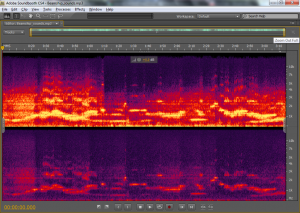Beamship Spectrogram Comparison
One way to see a sound is to create a spectrogram or sonogram of the digitized sound sample or waveform. A spectrogram typical shows time along the x-axis and frequency (pitch) along the y-axis and the amplitude is presented as a brightness in the plotted data. The brighter the colour the higher the amplitude. If you were ok at basic Mathematics at school you'll be able to understand a spectrogram.
Recently I've come across some attempts by various people to reproduce the infamous (among the Meier-knowledgeable Ufologists that is) Beamship Sound.
You can listen to it right here:
<mp3>Beamship sounds.mp3</mp3>
I've seen a spectrogram of the Beamship Sound before; Badr on the FIGU forum created one; however it wasn't a very clear graphic so I've reproduced it here:
If you examine the spectrogram above, which is only a 3-minute section of the 20-minute sample available from FIGU, then you can see that there are some obvious conclusions to make of it:
- There are multiple, simultaneous frequencies present at many time-points. For example at time-point 0:30 there are about 8 clear and distinct frequencies stacked above each other.
- The number of different frequencies changes frequently over time. For example, at time-point 0:30 there are 8 distinct frequencies but at 0:45 there are 4 or 5 then at 1:10 it drops to 3.
- The values of each of the frequencies are constantly increasing and decreasing in with time. The curliness of the horizontal lines on the spectrogram show this.
Now compare that to 2 recent efforts to duplicate the Beamship Sound.
Beamship Sound Reproduction Attempts
Amplifier Feedback
Some anonymous guy who calls himself Rorechof and Uzzz allegedly made this amplifier feedback effect with a guitar amp, tape recorder and a microphone:
<mediaplayer>http://www.youtube.com/watch?v=16L5TwUC_dY</mediaplayer>
Spectrogram of guitar amplifier feedback
[[File:Example.jpgFile:Example.jpg]]
A basic analysis shows clear differences in this sound sample to that of the Beamship Sound sample:
- The number of different frequencies changes infrequently over time. It has 5 or 6 visible and different frequencies present at most time-points.
- The values of each of the frequencies are not constantly increasing and decreasing in with time. The straightness of the horizontal lines on the spectrogram show this.
In fairness the creator of this amplifier feedback claimed that the variableness of the frequency values could be reproduced with a pitch shifter but I haven't seen this claim being implemented yet so it's not possible to verify that theory.

